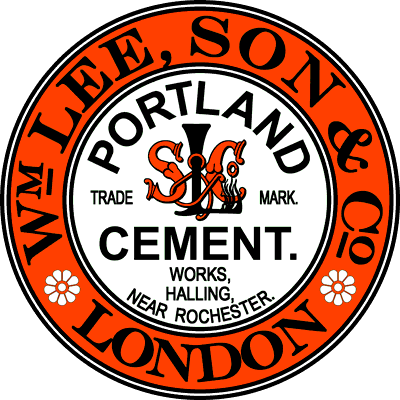
| The Lee's Brand used 1900-1911. |
Location:
- Grid reference: TQ707633
- x=570700
- y=163300
- 51°20'35"N; 0°27'4"E
- Civil Parish: Halling, Kent: the pits straddled the boundary between Halling and Snodland parishes.
Clinker manufacture operational: 1854-1915, 1918-1925
Approximate total clinker production: 2.10 million tonnes
Raw materials:
- Chalk was brought from various levels of the hillside by rail, in descending order:
- Upper (Lewes Nodular Chalk Formation: 88-90 Ma) and Middle Chalk (New Pit Chalk Formation: 90-92 Ma) from 568700,163600
- Middle Chalk (Holywell Nodular Chalk Formation: 92-94 Ma) and Grey Chalk (Zig-zag Chalk Formation: 94-97 Ma) from 569100,163600
- Chalk Marl (West Melbury Marly Chalk Formation: 97-100 Ma) from 569600,163500
- Up to the 1890s, Medway Alluvial Clay was used.
- From 1907, Gault Clay was brought from Mark Farm pit (569060,162000) by 1509 m ropeway (from 569025,162033 to 569557,163445) then by rail to the plant.
Ownership:
- 1854-1900 Lee, Son and Smith
- 1900-1911 William Lee, Son and Co. Ltd
- 1911-1925 BPCM (Blue Circle)
Before 1911 called the Halling Lime & Cement Works, but not to be confused with Halling Manor to the north. Originally the site of a lone lime kiln, William Lee (1801-1881) started the plant for lime manufacture in 1846, with a bank of nine lime kilns making white and hydraulic lime, Keene's cement and whiting. In 1854, Portland cement manufacture was commenced, using wet process, initially with four bottle kilns rated at 58 t/week. By 1864, there were 22 lime kilns and nine cement kilns in operation (155 t/week). Ten more cement kilns (285 t/week) were built during 1872-1876, four more (120 t/week) during 1879-1882, and a further six (180 t/week) during 1886-1891 so the total capacity was 740 t/week in 1895, ~14 MJ/kg. In 1900, the plant was described as having two 28 ft washmills, 29 settling backs, 36,000 ft2 of drying flats, 29 cement kilns and 47 lime kilns.
In 1900, Lee's refused to join the APCM, but was one of four companies that entered into "working arrangements" with the Combine (the others being Martin Earles, Queenborough and Wouldham). Although the "working arrangements" were mainly about carving up the market, it is clear that collaboration on manufacturing development also took place. During 1899-1903 Lee's experimented with Schneider kiln production, converting three bottle kilns. W L H Roberts, managing director, took out several patents for designs of these. In 1906, a set of Schneider kilns was built on the original bottle kiln bank. These were operated under natural draught, making a total 1100 t/week at 4.66 MJ/kg, and the raw material preparation was converted to partial dry process with elaborate new rawmill plant designed by Maxted & Knott, using a further 3.00 MJ/kg for raw material drying. These modifications were closely paralleled by similar improvements at APCM's Halling Manor plant. At the same time, the open lime kilns were replaced with eight continuous Brockham kilns on the original limekiln bank.
In 1911 with the BPCM takeover, the remaining bottle kilns were decommissioned, and in 1913 the Schneider kilns were converted to forced draught operation with capacity 1829 t/week at 4.80 MJ/kg (plus 3.00 MJ/kg for raw material drying). Its operations were combined with those of the adjacent Halling Manor after 1911. Capacity was 1600 t/week in 1924; the plant shut down during WWI, and ran only intermittently thereafter. The plant was described in detail in the BPCM 1924 schedule. The site had 250 m of wharf and two loading docks on the Medway, but also had a rail link from the inception of the Medway Valley line in 1856, thus enjoying flexible transportation throughout its life. The plant remained formally open until 1930, but does not seem to have produced clinker after 1925, although lime and whiting production continued for a while. Its closure was at the insistence of Henry Horne, whose own Holborough plant, adjacent to the south, was just starting up. The site was cleared and is now mostly waste land in which a few insignificant remains are visible. The quarries are also waste.
Power supply
The plant was initially direct-driven by steam, with separate engines for raw- and finish-milling. With the change to Schneider kiln production, a 1200 HP Musgrave double expansion tandem steam engine was installed for the raw material plant, which provided direct drive plus 320 kW of electricity. Electric power was supplemented with a 38 kW generator driven by steam engine and a 75 kW turbogenerator. The finish mills continued to be direct-driven by a 700 HP double expansion steam engine, which also generated 92 kW of electricity for fans and conveyors.
Rawmills
The plant initially had two small washmills close to the kilns. At some stage - perhaps 1872 - washmills were built at the north end of the plant - there were two 28 ft washmills in 1900. Around 1907, a new raw material plant was built over old slurry backs near the Schneider kilns. This had an 18 ft washmill for chalk and a 16 ft washmill for clay. At all times, chalk was first washed alone, and the clay was then washed into the resulting slurry in the second mill. In addition, the new plant had an elaborate dry process system, with chalk and clay being separately crushed and dried, then interground using eleven Roulette mills. The raw meal was then pug-milled with slurry and briquetted for feeding to the Schneider kilns.
No rotary kilns were installed.
Sources:
- Primary Sources:
- Greenhithe Archive
- BPCM 1924 schedule
- Aerial photography
- Ordnance Survey 1:2500 mapping
- BGS mapping and monographs
- Confirmatory Sources: